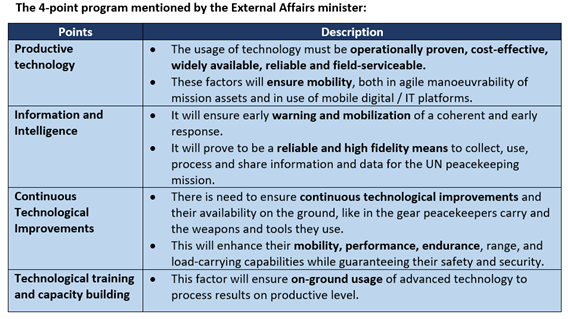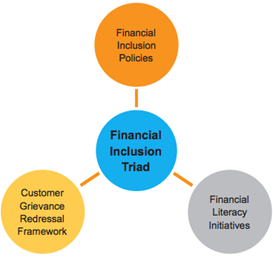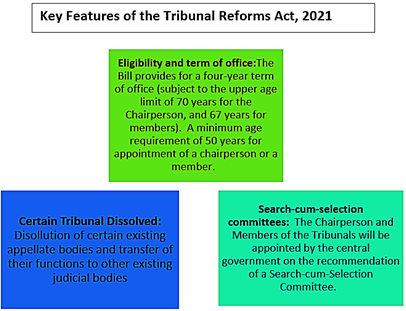Monday, 23rd August 2021
NITI Aayog Formula for Fuel, Electricity under GST Ambit
In News
Recently, NITI Aayog has proposed a formula whereby the two motor fuels (petrol and diesel) and electricity could be brought under the goods and services tax (GST).
About the News
- The Formula: According to the proposed formula, the Centre would compensate the states for potential revenue losses on account of shifting electricity – which is currently being taxed by the states exclusively – to GST for about six years.
- The GST Mechanism: As per Article 279A (5) of the Constitution, the GST Council shall recommend the date on which GST shall be levied on all excluded products, ie, petroleum crude, high-speed diesel, motor spirit (petrol), natural gas and aviation turbine fuel.
- Proposed Revenue Sharing: Under the current tax structure, the Centre and states collect taxes on the two motor fuels in the ratio of 6:4.
- For States: Besides getting a 50% share in the GST on petrol and diesel, the states could also benefit from higher devolution, as the Centre’s 50% revenue from the fuels will also be part of divisible pool, against under 6% now.
- For Centre: The Centre could favour keeping petrol and diesel at the highest slab of 28%, levy a cess at the rate of 50% or more to compensate states for inclusion of electricity duty in GST and also cover part of its losses due to transition of the fuels into GST.
- Benefits: The NITI Aayog is of the view that given a seamless input tax credit mechanism to be facilitated under GST, the industry’s post-tax profitability could increase, and result in substantial incremental growth in the government’s direct tax receipts.
Possible Impact of the Proposed Formula
- Initial Hiccups: The Centre’s revenue could see a decline at the start of the proposed regime, as it will be difficult to levy a revenue-neutral GST rate on petrol and diesel under GST. The RNR is seen to be very high, given the current excise duty structure.
- Impact of Compensation : Given that the Centre will require to make a bigger revenue sacrifice than the states for the plan because of its current very high tax rates on petrol and diesel, the compensation offer could be used as a bargaining tool for securing the states’ consent for the plan.
- Bringing a Balance: Compensation to states on account of losses on electricity duty might be brought down by 20% in each year. As the compensation gradually goes down, the Centre would appropriate a higher proportion of the cess proceeds.
Possible resistance from States
- Existing Issues: Many states are unhappy with the GST system as it hasn’t yielded the promised revenue productivity. States are also apprehending a revenue shock once the compensation period expires in June 2022, and are demanding an extension of the mechanism.
- Fiscal Autonomy: The idea of bringing energy under GST could likely be resisted by states, as they fear further loss of their fiscal autonomy as a result.
Sources:
Extreme heat causing harm to health- Lancet
In news
Papers published recently in the Lancet advocated immediate and urgent globally coordinated efforts to manage Extreme Heat so that its harmful impact on life and economy can be contained.

About the News
- The authors of the paper recommended immediate and urgent globally coordinated efforts to mitigate climate change and increase resilience to extreme heat by limiting additional warming and save lives by protecting the most vulnerable people.
- Two approaches to combat extreme heat:
- Climate change mitigation to reduce carbon emissions and alter further warming of the planet.
- Identifying timely and effective prevention and response measures, particularly for low-resource settings.
Why is extreme heat a cause of concern?
- Life threatening: When exposed to extreme heat stress, the body’s ability to regulate its internal temperature can be overwhelmed, leading to heat stroke.
- Also, physiological thermoregulatory responses that are engaged to protect body temperature induce other types of physiological strain and can lead to cardiorespiratory events.
- Increased healthcare cost and burden on health infrastructure: Extreme heat is associated with increased hospitalisations and emergency room visits, mental health issues, adverse pregnancy and birth outcomes, and increased healthcare costs.
- Reduced Work Productivity: Extreme heat also lessens worker productivity, due to heat stress. This is visible especially among the more than 1 billion workers who are exposed to high heat on a regular basis.
- Ominous forecast: The report predicts that these record-breaking temperatures will be more frequent, intense, and last longer because of human-induced climate change.

Sources:
- Extreme heat growing health issue, need to identify timely and effective prevention measures: Lancet
- About Extreme Heat
- Health in the world of Extreme Heat
Image Source:
RBI revises lockers rules
In News: The Reserve Bank of India (RBI) has recently come out with revised guidelines for the hiring of lockers.
The Revised Guidelines
- Non-liability on catastrophe: The banks shall not be liable for any damage and/or loss of contents of locker arising from naturalcalamities or Acts of God like earthquake, floods, lightning and thunderstorm or any act that is attributable to the sole fault or negligence of the customer. But they will exercise appropriate care to their locker systems to protect their premises from such catastrophes.
- Safer premises: It is the responsibility of banks to takeall steps for the safety and security of the premises in which the safe deposit vaults are housed.
- Limit on the Liability: In case of incidents like fire, theft/ burglary/ robbery, dacoity or fraud committed by its employee(s), the banks' liability shall be for an amount equivalent to one hundred times the prevailing annual rent of the safe deposit locker.
- Non-hazardous lockers: The banks will be required to incorporate a clause in the locker agreement prohibiting the hirer from keeping anything illegal or hazardous in lockers.
- Transparency in Allotment: Banks need to maintain a branch-wise list of vacant lockers as well as a waitlist in Core Banking System (CBS) or any other computerized system compliant with Cyber Security Framework, for the purpose of allotment of lockers and ensure transparency in allotment of lockers.
- Systematic Wait listing: The banks shall acknowledge the receipt of all applications for allotment of locker and provide a wait list number to the customers, if the lockers are not available for allotment.
- Term Deposit for Rent on new lockers: To ensure prompt payment of locker rent, banks obtain a Term Deposit, at the time of allotment, which would cover three years' rent and the charges for breaking open the locker in case of such eventuality.
Source:
- RBI revises lockers rules: Bank liability limited to 100 times of annual rent
- RBI announces revised norms for bank lockers: All you need to know
- RBI revises guidelines for locker facility; banks' liability to be 100 times of annual rent
Image Source:
Vehicle Scrappage Policy
In News
The government recently launched the Voluntary Vehicle-Fleet Modernization Program (VVMP), also known as the Vehicle Scrapping Policy.
About the News
- The Policy: It outlines key steps to set up of support infrastructure to implement the scrappage policy with automated testing stations (ATS) and registered vehicle scrapping facilities (RVSF).
- RVSP: The RVSFs will ensure that vehicles are scrapped in an environment-friendly and safe manner. All RVSF applications will be processed through a central single window clearance portal.
- State/ UT governments will have to clear the proposal within 60 days else proposal will be deemed approved
- Fitness Test: The policy stated that Commercial Vehicles (CVs) to undergo fitness test every 2 years for first 8 years and annually thereafter.
- Mandatory automated fitness testing for Heavy Commercial Vehicles (HCVs) is to be effective from April 1, 2023.
- For all the other categories of CVs and Private Vehicles (PVs), fitness testing through ATS is proposed to be mandated in a phased manner from June 1, 2024 onwards.
- Renewal: Valid fitness certificate for PVs is necessary for renewal of registration after 15 years. Renewal will be valid for 5 years.
- Disincentives for keeping old vehicles:
- States can levy an additional ‘Green Tax’
- Hike in renewal of registration fee for private vehicles
- Increase in renewal fees of fitness certification for commercial vehicles
- Automatic deregistration of unfit vehicles
- Vehicles to be exempted:
- Strong hybrids and electric vehicles
- Vehicles using alternative fuels such as CNG, ethanol and LPG
- Farm and agricultural equipment such as tractors, tillers, and harvesters

What is Vehicle Scrappage?
- Scrappage is the process in which ELV (End of Life Vehicle) is disposed off. This may be done using shredders that tear them down into tiny pieces of metal which can then be recycled. Other non-metal parts of the vehicle are then disposed off in a sustainable process.
- A vehicle will be declared as End-of-Life or unfit if it fails the automated fitness test, the allowed retest and reinspection test if ordered by the appellate authorities.
The Vehicle Scrappage Potential of India
- Vehicle Market: India is the world’s fifth-largest 4-wheeler market. India has 51 lakh light motor vehicles that are more than 20 years old and 34 lakh over 15 years old.
- Unorganized Sector: The scrapping facilities are highly unorganised, located in major cities and dismantling is done manually, which makes the process inefficient. The recycling, recovery and reuse from the scrapped vehicles is very limited, which causes serious economic loss.
- High Scrap Imports: India imported 23,000 crore worth of scrap steel during the last year as our scrapping is not productive and we are not able to recover rare earth metals.
Possible Benefits
- Circular Economy: Vehicle scrapping will help phase out unfit and polluting vehicles in an environment-friendly
- Efficiency in material use, recycling and reuse of materials and products will aid circular economy.
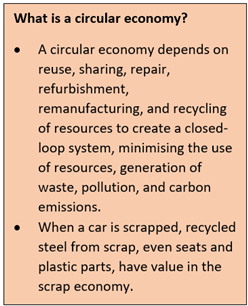
- Earnings for government: The vehicle scrappage policy will help both Centre and states earn up to ₹40,000 crore in GST. It will also cut India's steel scrap import.
- Globally, a scrappage policy has been followed by boost in demand in the auto manufacturing sector.
- Incentives for Customers: A certificate that will be awarded to individuals for scrapping the old vehicle could waive off the registration fees for the purchase of a new vehicle. Exemption in road tax shall also be provided.
- Savings: Cost of new vehicles will also come down as the scrap would provide copper, aluminium, steel, plastic, and rubber to the industry. If we recycle on a continuous basis, we can recover 99% of the materials.
- Geo-political Advantage: There is no scrapping infrastructure in our neighbouring countries. Scrapping facilities at the Kandla port in Kutch and Alang ship-breaking yard in Bhavnagar can help India become the scrap recycling hub of entire South-East Asia.
- Aid Aatmanirbhar Bharat: The scrappage policy will be a developmental milestone of the Indian auto industry promoting ‘Aatmanirbhar Bharat’, with automated testing stations and registered vehicle scrapping facilities across the country.
- The government expects to generate employment for about 35,000 people at vehicle fitness centres and scrapyards and a collective investment of Rs 10,000 crore.
- Organized Scrapping Industry: The scrappage policy will help regularize and standardize the unorganised vehicle scrappage industry in India, end unsafe dismantling practices and unhealthy working environment and improve recycling efficiency.
Challenges
- Supporting Infrastructure: For the proposed policy to succeed, the most important step is to build an infrastructure of testing and scrapping centres quickly across the country.
- Currently, India has just seven automated fitness test centres and two authorised scrappage centres, which is inadequate to cater to the market.
- Deregistration Issues: The process to deregister vehicles also needs to be simplified. At present, deregistering vehicles is a dreadful experience for most owners who want to sell or scrap their old vehicles, thereby discouraging many interested in discarding old vehicles.
- Lack of Fitness Certificates: There is lack of Fitness Certificates with as many as 1.7 billion vehicles, which are more than 15 years old. So, in such a scenario, determination of vehicles for scrapping becomes difficult.
- Role of States: There can be roadblocks as the state governments have to decide the financial incentives for replacement of vehicles in terms of waiver of registration charges, reduced road taxes as well as disincentives for end-of-life vehicles in the form of higher registration renewal charges & road taxes.
Way Forward
- Role of OEMs: For the realisation of the promising idea behind this policy, the Original Equipment Manufacturers (OEMs) in India should come forward to start Authorized Vehicle Scrapping Facility (AVSF) under the vehicle scrappage policy.
- OEMs may also market the policy through their dealer network to create more awareness among the customers. It would also boost their retail sales.
- Make AVSFs Lucrative: The government can come up with a revenue chart for running the AVSFs so that they become lucrative for professional scrappage organizations and OEMs to participate and invest money in them.
- Future Ready: The AVSFs should also be future-ready to handle the new energy vehicles like EVs or Li-Ion batteries. Future design and material of the vehicles and their parts shall be such that they can be recycled at their ELV stage with minimum wastage.
Question: Discuss the Vehicle Scrappage Policy of Ministry of Road Transport and Highways. Elaborate the challenges and way forward in execution of the policy.
Sources:
- Vehicle Scrappage Policy to speed up economic growth, says Nitin Gadkari
- PM launches Vehicle Scrappage Policy
- Opinion: The environmental and economic dimensions of the vehicle scrappage policy
- What will be the impact of scrappage policy on India’s EV market?
- Vehicle Scrappage Policy – 2021
- Explained: Why scrap old vehicles, and how?
- VEHICLE SCRAPPAGE POLICY 2021: EXPECTATIONS AND CHALLENGES
- Government announces details of vehicle scrappage policy
This Day in History - MGNREGA
On August 23, 2004, the Lok Sabha passed the MGNREGA Act, which ensured livelihood for millions of poor living in rural areas. The MGNREGA initially covered 200 of the most impoverished districts across India. MGNREGS guarantees at least 100 days of paid employment in every financial year to adults who are willing to take up unskilled manual work at a minimum wage. Apart from providing employment, it aimed to build sustainable infrastructure in the rural fold of the country.
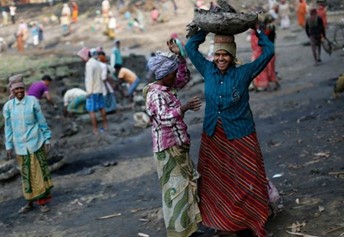
Source:
Image of the Day - Sri Veerabhadra Swamy Temple
This is the image of paintings on the roof of the Sri Veerabhadra Swamy temple at Lepakshi in Anantapur district, Andhra Pradesh. The shrine of Lepakshi, which shelters Veerabhadra Swamy temple is considered one of the outstanding ancient shrines edifying the medieval classical phase of art and architecture. The group of temples at Lepakshi were built under the aegis of Virupanna, a minister under King Venkatapatiraya in 1533 A.D. These harmoniously colourful frescos are fabricated around the mythology of Lord Shiva and regarded as unique landmarks of the 16th Century A.D.
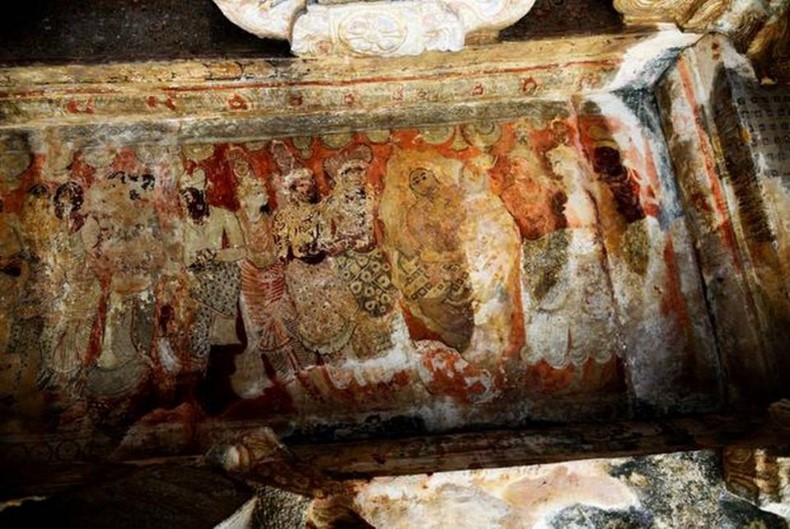
Source:
Surangam System
- Context: Future of Karez System of Afghanistan uncertainwhereas a similar system named Surangam in South India is thriving.
- Surangams are special water harvesting structure usually found in northern Kerala and southern Karnataka.
- This is a tunnel dug through a laterite hillock from the periphery of which water and moisture seeps out.
- Surangamsare similar to qanats (underground tunnel systems that bring groundwater or spring water to the earth's surface) which once existed in Mesopotamia and Babylon around 700 BCE which later spread to Egypt, Persia and India.
- This system has been very effectively used for domestic and agriculture purposes in dry areas of northern Malabar.
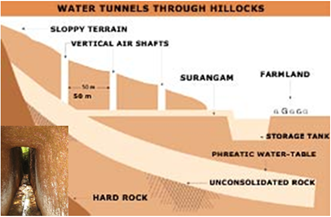
Source:
Image Source:
The Prime Global Cities Index
- Context: Delhi, Mumbai, and Bengaluru have slipped in Knight Frank’s Prime Global Cities Index Q2 2021.
- The Prime Global Cities Index is a valuation-based index tracking the movement in prime residential prices in local currency across more than 45 cities worldwide using Knight Frank’s global research network.
- Prime residential property is defined as the most desirable and most expensive property in a given location, generally defined as the top 5 per cent of each market by value.
- India’s national capital has slipped five spots, to the 37th position from 32nd, in the ranking with Mumbai and Bengaluru that moved down to 40th and 43rd rank from 36th and 40th in 2021.
- Globally, 35 cities witnessed a rise in prime residential prices among which 13 registered double-digit priced growth up from just one a year ago.
- This can be attributed to a strong buyer appetite for residential due to extended time spent indoors, appreciation for larger homes and low-interest rates regime followed by central banks globally.
- Price changes in some important cities- Toronto (27 %), Shanghai (21 %), Guangzhou (20 %), Seoul (20 %) and Bangkok (-6.4 %).
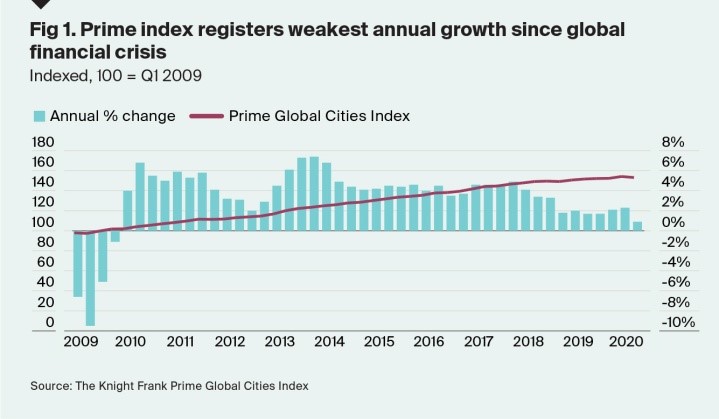
Source:
Image Source:
Nuclear Fusion Breakthrough
- Context: An experiment carried out in the Lawrence Livermore National Laboratory, California has made a breakthrough in nuclear fusion research.
- In the experiment, precision lasers were used to heat a small target or fuel pellets containing deuterium and tritium that fused and produced more than 1.3 megajoules of energy.
- Nuclear fusion is defined as the combining of several small nuclei into one large nucleus with the subsequent release of huge amounts of energy.
- This energy is a good choice as the baseload energy in the future as it has various advantages, such as inexhaustibility of resources, inherent safety, no long-lived radioactive wastes, and almost no CO2 emissions.
- Moreover, reproducing the conditions at the centre of the Sun will allow the scientific community to gain insights into the Big Bang, etc.

Source:
Image Source:
India's Largest Floating Solar Power Plant
- Context: NTPC has commissioned a 25 MW project, India’s largest floating solar power plant in Visakhapatnam, Andhra Pradesh.
- Floating solar reduces temperature-related losses due to the cooling effect of water they float on, reduce evaporation rate of water bodies, and have lower maintenance cost.
- They also have inherent advantages in land requirement as they locate the power generators over non-farming and non-forest land.
- It is the first solar project to be set up under the power ministry’s 2018 flexibilization scheme allowing generators to supply power from any of their sources, based on plant efficiency, to reduce discoms’ cost.
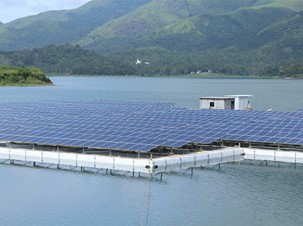
Source:
Image Source:
India’s gendered digital divide - ORF
This article throws light on an important issue - gendered digital divide. While COVID 19 has propelled a shift towards digitisation, it has amplified another trend: the gendered digital divide.
It identifies disadvantage for women out of which this gendered digital divide originates - rural-urban digital divide, income-based digital divide between households and intra-household discrimination. It also identifies programmes and initiatives which should be prioritised to address this issue.
Why you should read this editorial?
- The articles provides important data points for gendered digital divide.
- To understand the issue of gendered digital divide in detail - causes, implications and possible solutions.
Source:
It is time to end judicial feudalism in India- IE
Essence: The expression of subordinate courts is feudal and does not signify that the judges are subordinate to the higher judiciary. The subordinate judges are limited in jurisdiction but supreme within their own jurisdiction. The power of superintendence of the subordinate judiciary by the High Courts is not absolute. The Himachal Pradesh High Court recently ordered that all the courts in the state other than the high court shall not be referred to as subordinate court but as trial courts. This is step in the right direction and there is a need to amend the constitution to give detailed performance norms for the high courts to exercise control over lower judiciary.
Why should you read this article?
- To understand the constitutional framework of the judiciary in India and the position of the subordinate judiciary within it.
- To understand the need for independence of the subordinate judiciary and the problems plaguing them and measures needed.
Source:
Real estate deserves industry status- HBL
Essence: India’s real estate in partnership with infrastructure has driven GDP growth over the years; and it has the potential to help achieve the goal of evolving into a $5 trillion economy. The inclusion of real estate among those sectors granted ‘industry status’ will directly reflect in terms of availability of low-cost credit, which has been the single largest challenge for real estate. The article further suggests several steps which should be taken to make the future of Indian real estate eco-friendly, where the focus will shift from just creating ‘customer delight’ to a situation where the customer will also be a stakeholder.
Why should you read this article?
- To get an overview of India’s real estate status and issues associated with it.
- To understand, how inclusion of India’s real estate among sectors having industry status will reflect in low-cost credit.
- To understand the arguments for granting industry status to real estate and what possible steps India should take to tackle the same.
Sources:
MGNREGA helped in changing the face of village
Background
- In 2006, in Barmani village, Sidhi, Madhya Pradesh, only a handful of elders were left as the rest had migrated for work in cities.
- Villagers were abandoning farming as community and the villages had a few dug wells, that too were either choked up with silt or had dried up.
How MGNERGA changed the face
- Under MGNREGA, village has ensured that at least 75 per cent of the works undertaken are related to water conservation.
- This increased the water table in the village due to construction of check dams and contour trenches.
Outcome
- People in Sidhi district now farm 10 months a year
- Even those who had quit farming are returning to it
- 2,300 residents are established farmers now with multiple crops to tend to.
Sources:
Share the article
Get Latest Updates on Offers, Event dates, and free Mentorship sessions.

Get in touch with our Expert Academic Counsellors 👋
FAQs
UPSC Daily Current Affairs focuses on learning current events on a daily basis. An aspirant needs to study regular and updated information about current events, news, and relevant topics that are important for UPSC aspirants. It covers national and international affairs, government policies, socio-economic issues, science and technology advancements, and more.
UPSC Daily Current Affairs provides aspirants with a concise and comprehensive overview of the latest happenings and developments across various fields. It helps aspirants stay updated with current affairs and provides them with valuable insights and analysis, which are essential for answering questions in the UPSC examinations. It enhances their knowledge, analytical skills, and ability to connect current affairs with the UPSC syllabus.
UPSC Daily Current Affairs covers a wide range of topics, including politics, economics, science and technology, environment, social issues, governance, international relations, and more. It offers news summaries, in-depth analyses, editorials, opinion pieces, and relevant study materials. It also provides practice questions and quizzes to help aspirants test their understanding of current affairs.
Edukemy's UPSC Daily Current Affairs can be accessed through:
- UPSC Daily Current Affairs can be accessed through Current Affairs tab at the top of the Main Page of Edukemy.
- Edukemy Mobile app: The Daily Current Affairs can also be access through Edukemy Mobile App.
- Social media: Follow Edukemy’s official social media accounts or pages that provide UPSC Daily Current Affairs updates, including Facebook, Twitter, or Telegram channels.


